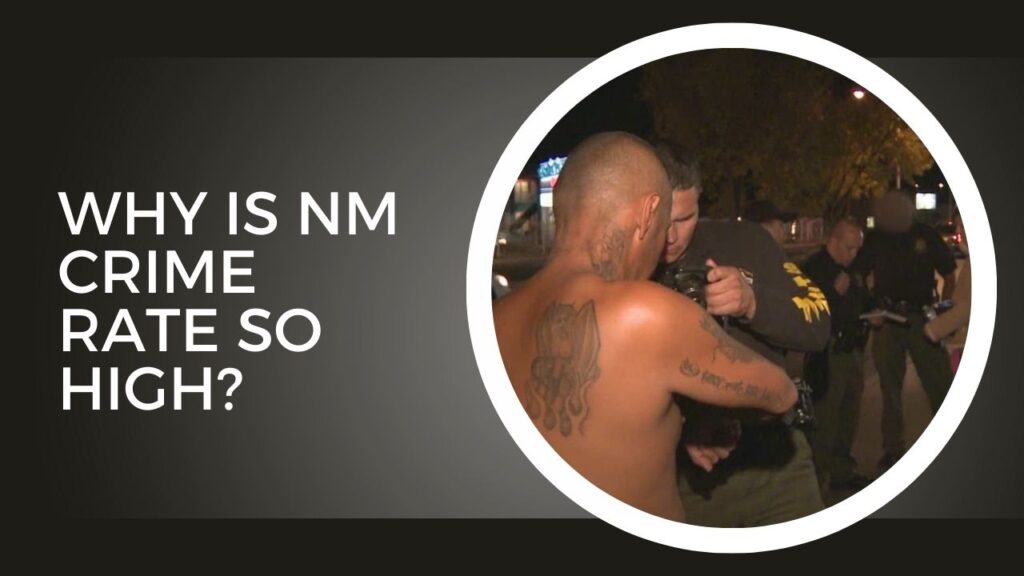Why Is NM Crime Rate So High? New Mexico’s high crime rate is driven by factors such as widespread drug abuse, particularly opioids.
New Mexico consistently ranks among the states with the highest crime rates in the United States, a trend that has sparked widespread concern among residents, policymakers, and law enforcement officials.
In particular, major cities like Albuquerque have faced significant challenges related to both violent and property crimes.
The state’s crime rate is a multifaceted issue, influenced by various factors ranging from drug abuse and poverty to mental health struggles and homelessness.
But what exactly is driving this troubling trend, and what can be done to reverse it?
Let’s explore the underlying factors contributing to New Mexico’s high crime rate, as well as the steps being taken to address them.
What Contributes to New Mexico’s High Crime Rate?
New Mexico’s crime issues are complex, shaped by a range of economic, social, and systemic factors. Below are some of the primary drivers behind the state’s high crime rates. [Why Is NM Crime Rate So High?]
Drug Abuse and Addiction
One of the most significant contributors to New Mexico’s crime rate is drug abuse, especially the widespread use of opioids, methamphetamines, and other illicit substances.
According to experts, the state has become a key target for drug trafficking, with a large percentage of crimes directly tied to substance abuse.
The Influence of Opioids and Methamphetamines
The opioid crisis has reached epidemic levels in New Mexico, particularly in rural areas. The use of heroin, fentanyl, and prescription painkillers is rampant, contributing to a rise in overdose deaths and drug-related crime.
Methamphetamine use has also been prevalent in both urban and rural communities. These drugs not only increase the likelihood of violent crime, such as domestic violence, theft, and assault, but also strain public health resources.
Drug addiction leads many individuals to engage in criminal activity to support their habits, which in turn impacts crime statistics across the state. [Why Is NM Crime Rate So High?]
Proximity to Drug Trafficking Routes
New Mexico’s location along major interstate highways has made it a hub for drug smuggling. Criminal organizations exploit the state’s geography to distribute illicit substances across the U.S.
This trafficking fuels local gang activity, and drug-related crimes become more common in areas with high drug distribution. [Why Is NM Crime Rate So High?]
Organized crime groups often use New Mexico as a transit point for methamphetamine, heroin, and fentanyl, which leads to an uptick in violence and criminal activity.
Socioeconomic Disparities
The deep economic challenges faced by many New Mexicans are another important factor contributing to high crime rates. [Why Is NM Crime Rate So High?]
Poverty, lack of education, and high unemployment rates are all linked to higher crime rates in both urban and rural areas.
Poverty and Unemployment as Root Causes
New Mexico ranks as one of the poorest states in the U.S., with a significant portion of the population living below the poverty line.
According to recent census data, nearly 19% of New Mexicans live in poverty, making it one of the highest rates in the nation.
Poverty often breeds desperation, leading some individuals to resort to criminal activity as a means of survival.
Lack of affordable housing, limited access to education, and the absence of job opportunities in certain regions contribute to an environment where crime is more likely to thrive.
With few economic opportunities, many individuals turn to illegal activities to make ends meet. [Why Is NM Crime Rate So High?]
The Connection Between Economic Inequality and Crime
Studies show that areas with greater economic inequality tend to experience higher crime rates. New Mexico’s large disparity between the wealthy and those living in poverty is an indicator of this.
Areas with fewer opportunities often see more property crimes, like burglary and theft, as residents struggle to meet basic needs.
The economic divide is particularly pronounced in cities like Albuquerque, where wealthy neighborhoods are in close proximity to areas suffering from extreme poverty.
This socioeconomic inequality increases the likelihood of criminal behavior, as individuals in low-income areas are more likely to engage in crime out of financial necessity or frustration.
Mental Health and Homelessness
The lack of adequate mental health services and the growing homelessness crisis are contributing to New Mexico’s crime issues. [Why Is NM Crime Rate So High?]
Mental health struggles and homelessness are often intertwined, and both can exacerbate criminal behavior.
How Lack of Mental Health Services Contributes to Crime
In New Mexico, mental health care resources are stretched thin, and many individuals with mental illnesses go untreated.
This can lead to increased instances of violence, self-harm, and criminal activity. [Why Is NM Crime Rate So High?]
According to mental health professionals, many individuals with severe mental health conditions, such as schizophrenia or bipolar disorder, engage in criminal behavior due to untreated symptoms.
The lack of adequate mental health care means that these individuals often end up in the criminal justice system rather than receiving the treatment they need.
This places a strain on local jails and prisons, which are not equipped to deal with individuals who require psychiatric care. [Why Is NM Crime Rate So High?]
The Rising Homelessness Crisis and Its Link to Criminal Activity
Homelessness in New Mexico has steadily increased in recent years. People who are homeless often struggle to access stable housing, food, and healthcare, and many turn to crime as a means of coping with these hardships.
Homelessness is not just a social issue but a public safety concern, as individuals without shelter may resort to petty theft, trespassing, or other crimes to survive.
The lack of proper shelters, mental health facilities, or support systems for the homeless population exacerbates the problem, creating an environment where crime is more likely to occur. [Why Is NM Crime Rate So High?]
Case Studies: The Impact of Crime in Major Cities
While crime is a statewide issue, it is particularly concentrated in New Mexico’s urban centers, where the challenges are most acute.
Albuquerque: New Mexico’s Crime Hub
Albuquerque, New Mexico’s largest city, is often cited as one of the most dangerous cities in the country. [Why Is NM Crime Rate So High?]
With a population over 500,000, the city faces a range of crime problems, including violent crime, property crime, and drug-related offenses.
Discussion of Crime Rates in Albuquerque
According to recent data, Albuquerque has one of the highest violent crime rates in the nation, including a high number of homicides and aggravated assaults.
Many of these crimes are tied to gang violence and the drug trade, which has a strong presence in the city.
Law enforcement officials estimate that gang members are responsible for a significant portion of the city’s violent crime, including drug distribution and shootings.
The police department has worked to curb gang activity, but the ongoing battle against drug trafficking and organized crime continues to pose a serious challenge. [Why Is NM Crime Rate So High?]
Efforts by Local Law Enforcement to Combat Crime
Local law enforcement has implemented various strategies to reduce crime, including community policing, crime prevention programs, and anti-gang initiatives.
However, the high volume of cases and lack of resources often complicate these efforts, making it difficult to achieve lasting results. [Why Is NM Crime Rate So High?]
Albuquerque police have been criticized for not having enough officers to patrol high-crime areas effectively, and while crime reduction programs have had some success, they are often overwhelmed by the scope of the problem.
Other Cities Facing Crime Challenges
While Albuquerque bears the brunt of New Mexico’s crime, smaller cities like Santa Fe, Las Cruces, and Rio Rancho are also experiencing rising crime rates.
These areas are dealing with similar issues of poverty, drug abuse, and limited law enforcement resources.
Rural areas, in particular, face challenges related to limited access to policing and public health services, making it harder for communities to combat crime effectively. [Why Is NM Crime Rate So High?]
What Is Being Done to Address the Issue?
Although New Mexico’s crime rate remains high, several efforts are underway to address the root causes of criminal activity and reduce violence across the state. [Why Is NM Crime Rate So High?]
Law Enforcement Strategies
State and local police have focused on improving their crime-fighting tactics, with particular attention on tackling the drug trade, combating gang violence, and curbing property crimes.
Programs like the Albuquerque Police Department’s “Operation Clean Sweep” aim to reduce drug-related crimes and gang activity by increasing patrols and enhancing surveillance.
These strategies have had some success, but the widespread nature of the issues means that much more is needed to see substantial long-term reductions in crime.
Community Programs and Initiatives
In addition to law enforcement efforts, community organizations are working to tackle crime from a social perspective.
Programs aimed at addiction recovery, mental health treatment, and homelessness prevention have been implemented throughout the state.
These initiatives are designed to address the root causes of criminal behavior and offer alternatives to incarceration. [Why Is NM Crime Rate So High?]
For example, programs like “Bridges to Recovery” aim to provide treatment to individuals with substance abuse issues, while other programs focus on helping the homeless access permanent housing and mental health care.
State-Level Responses
New Mexico’s state government has also been exploring larger-scale solutions, including funding for mental health services and affordable housing.
Governor Michelle Lujan Grisham has pledged to tackle both the opioid epidemic and homelessness, with programs that focus on prevention, education, and rehabilitation.
The state’s investments in mental health services aim to provide long-term solutions by addressing the underlying issues that often lead individuals to engage in criminal behavior.
See Also: Why Is U.S. 95 So Dangerous from Traffickers In Nevada?
Conclusion: Why Is NM Crime Rate So High?
The high crime rate in New Mexico is driven by a combination of social, economic, and systemic factors. [Why Is NM Crime Rate So High?]
Drug abuse, poverty, economic inequality, and inadequate mental health care all contribute to the state’s crime issues.
However, local law enforcement, community organizations, and state government efforts are working to combat these challenges.
A comprehensive approach that tackles the root causes of crime while improving community safety is necessary to reduce crime rates and create a safer New Mexico.
Only through collaborative efforts involving law enforcement, public health agencies, and community leaders can the state hope to break the cycle of violence and create lasting change.
FAQs
How does New Mexico’s crime rate compare to other states?
New Mexico consistently ranks among the highest in the U.S. for violent crime, particularly in cities like Albuquerque. [Why Is NM Crime Rate So High?]
Which types of crimes are most prevalent in New Mexico?
Violent crimes, including aggravated assault and homicide, are most prevalent, followed by property crimes such as burglary and auto theft.
What is the state doing to reduce crime rates in Albuquerque?
Albuquerque’s police department has focused on anti-gang initiatives, crime prevention programs, and increased patrols to curb violent crime.
How do socioeconomic conditions contribute to New Mexico’s crime rate?
High levels of poverty, unemployment, and economic inequality create an environment where crime is more likely to occur, as people struggle to meet basic needs. [Why Is NM Crime Rate So High?]

Hi, I’m Fernando Pham, and welcome to WhyDetails.com! I’m from San Francisco, and I love exploring questions and sharing answers through my blog.



